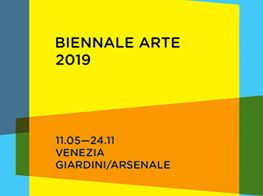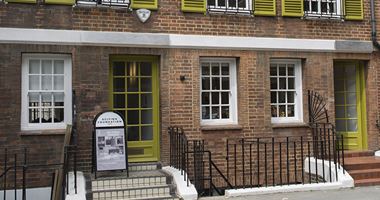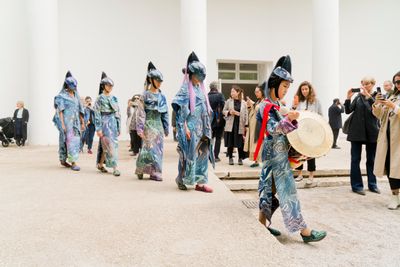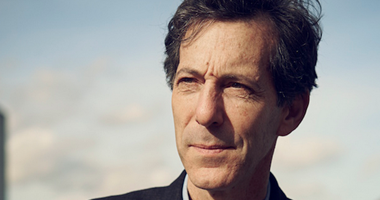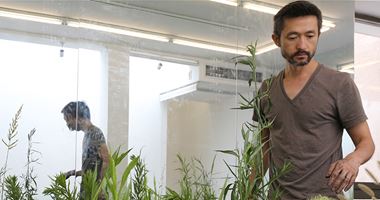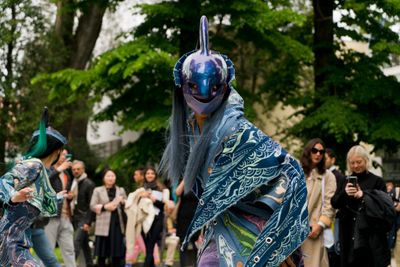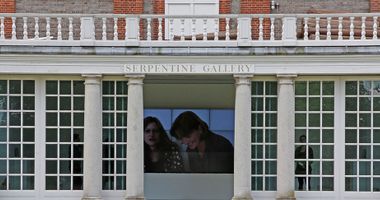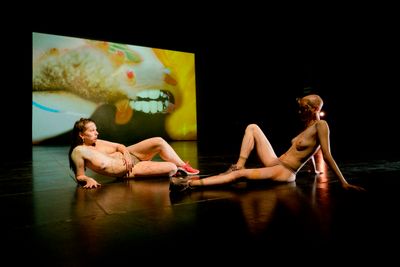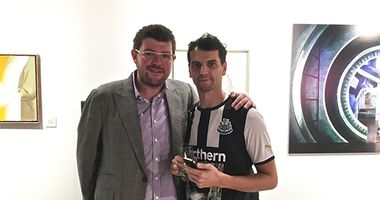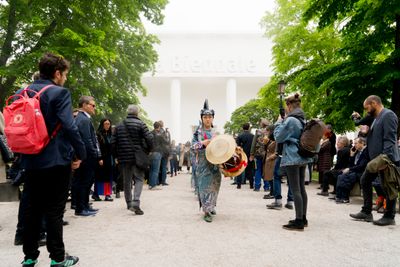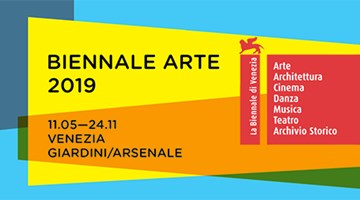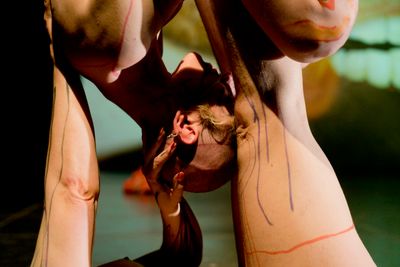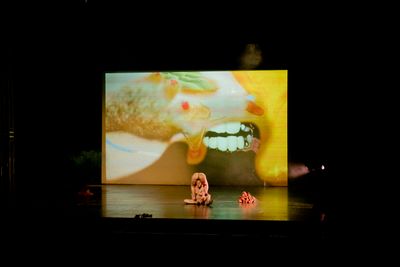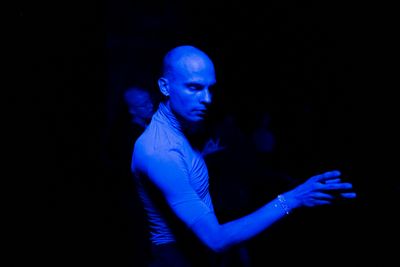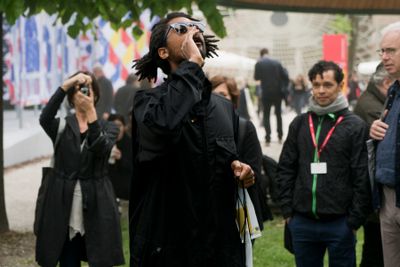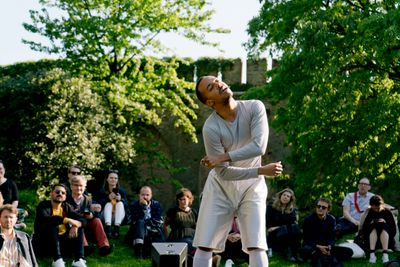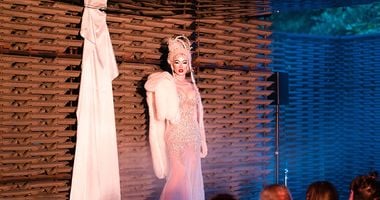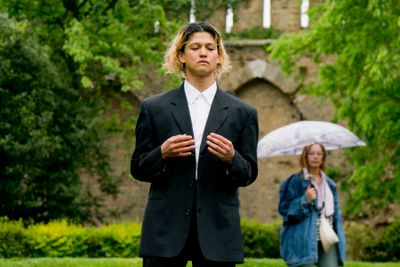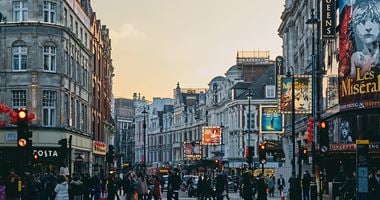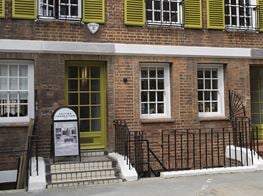Delfina's Aaron Cezar on Performance at the Venice Biennale
Aaron Cezar. Courtesy Delfina Foundation. Photo: Tim Bowditch.
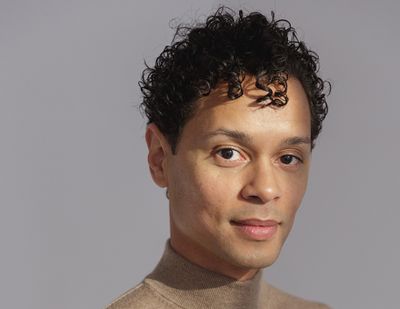
Aaron Cezar. Courtesy Delfina Foundation. Photo: Tim Bowditch.
With first degrees in Economics and Dance from Princeton University and a postgraduate degree in Creative Industries from King's College London, Aaron Cezar exists between various art worlds—a productive space for his work as the founding director of Delfina Foundation, which was established in 2007.
Funded by the founder and chair of the board of trustees, Delfina Entrecanales, as well as other private donors and public grants, Delfina Foundation positions itself primarily as a space for the development of artists, curators, writers, and collectors through its residency programmes, approaching its mission from a place of intimacy and hospitality that encourages like-minded cultural workers to develop together and share their practices with the public.
The Foundation's first thematic programme, The Politics of Food, was launched in 2014 and addresses issues such as biodiversity or access to food through events as diverse as bread-making workshops and conversations on global food policy.
Collecting as Practice is a newer programme, established in 2017, which invites collectors to come for one- to three-week residencies where they can question their role within the art world and develop their methods of collecting.
Prior to his work with the Delfina Foundation, Cezar was the project director of Metal—an arts incubator established by British theatre director and producer Jude Kelly CBE—later becoming the managing director of the organisation's consultancy for projects related to urban regeneration.
He continues to be very involved in the international contemporary art sphere through positions outside of Delfina Foundation, including serving on various juries (such as the Jarman Awardin 2012, and the LIVE WORKS Performance Act Award in 2016) and advisory groups (including All Change Arts and Alserkal Avenue), as well as working on curatorial projects in partnership with other organisations, such as Echoes & Reverberations at Hayward Gallery (23 June–16 August 2015) and Delfina in SongEun: Power play at SongEun Art Space in Seoul (30 August–1 December 2018).
Most recently, Cezar co-devised the performance programme of the 58th Venice Biennale, May You Live In Interesting Times (11 May–24 November 2019), which was commissioned by Arts Council England and co-produced by the Delfina Foundation and the Venice Biennale within the Biennale's public programme, Meetings on Art. Departing from Ralph Rugoff's concept, May You Live In Interesting Times, the performance programme seeks to activate in-between spaces, which Cezar defines as 'places of potential', and to challenge existing forms of representation with new forms of language.
The opening weekend featured performances by eight artists, including Florence Peake and Eve Stainton, boychild, Victoria Sin, and Zadie Xa. The second part of the programme, which will take place during the Venice Biennale's final weekend, will present new works by Vivian Caccuri, Cooking Sections, Invernomuto, Paul Maheke and Melika Ngombe Kolongo (Nkisi), Vivien Sansour, and Zheng Bo.
One stand-out contribution during the opening weekend was Zadie Xa's Grandmother Mago (2019), a processional piece that was reimagined from a 2016 performance at the Serpentine Gallery in London for the Giardini. Grandmother Mago combines references to the matriarchal figure of Grandmother Mago, a mythical being who is said to have created Korea out of her own physical exertions and bodily waste, with the image of orcas, who are matrilineal and have various pods near Vancouver, Xa's birthplace.
Xa, who is Canadian with Korean heritage, explained that her interest in orcas stems from the fact that they pass down survival tactics through a matrilineal line. This complex set of references came together visually in the movement of dancers participating in the procession, who were accompanied by percussionist Jihye Kim.
Their movements were sometimes undulating and marine-like and other times rigid and assertive, reflecting the influence of the Korean talchum mask dance. The performance's aggression and compelling visuals offer an intriguing foil to the very personal diasporic narrative that Xa draws from and rewrites through the piece.
Another highlight at Venice was Florence Peake and Eve Stainton's Apparition Apparition (2019), a new site-specific commission created for the Teatro Piccolo at the Arsenale, which stems from the artists' artistic-romantic collaboration, but expands in meaning to address the position of love within the context of environmental catastrophe.
Within a conceptual framework exploring issues of extinction and environmental degradation, the imagery representing the natural world in Apparition Apparition was articulated through fecund, oozing, and decaying organic bodies represented in the form of sculptures and an animated stage backdrop.
The performance consisted of three movements, the first of which saw the artists moving through the crowd and whispering requests that audience members drew on them with markers, creating a sense of intimacy while establishing the boundaries of what was and was not acceptable.
The second movement took the artists to the theatre stage, where they entangled themselves together before breaking apart and re-entangling themselves in another formation.
Between poses, Peake and Stainton engaged in intimate, inaudible negotiations. For the final movement, the artists stepped down from the stage and withdrew into the audience. The overall effect of the piece was one of tenderness and vulnerability, with the possibility of finding pleasure in a dystopian future.
In this conversation, Cezar discusses the genesis of the performance programme and how its themes relate to his practice as a curator-administrator.
PCThe Venice Biennale has not traditionally included a performance programme—how did it come into being this year?
ACThis is perhaps the first major performance programme that has happened as part of the official public programme of the Venice Biennale. Of course, there have been performances before, within the national pavilions, which are not run by the Biennale itself. For example, Alexandra Pirici and Manuel Pelmuş at the Romanian Pavilion in 2013 and Anne Imhof for the German Pavilion in 2017.
This year, Lithuania won the Golden Lion with a performative pavilion. It's great that the performance programme is set within this context of appreciation of what performance can bring to our understanding of the world around us.
The performance programme is a co-curated series within Meetings on Art, the official public programme of the Biennale. As curator of the 58th Venice Biennale, Ralph Rugoff is ultimately responsible for Meetings on Art, which includes talks, readings, and other activities.
I first got an email on 2 January 2019 from Ralph, asking whether I would consider co-curating a performance programme with him. Initially I was confused about whether it was 2018 or 2019, then I realised there were only four months to prepare! My first reaction was that he must think I am either really gullible, crazy, or really good, to take something like this on—or a mixture of those things.
In our subsequent conversations, we first talked about sites. Not artists, but places of potential. We discussed how performance would be a very strong way to animate the sites around the Biennale. Ralph was very excited by the many undiscovered spaces as well as the transitional ones.
Then we started talking about his theme, May You Live In Interesting Times. One of its many tenets explores how we define and categorise things, and what exists in between the cracks.
How can the space in between be as stable as the spaces we are going to and arriving from? How is the 'in-between' a space for thinking about new identities and who we are, or where we're going? And how can you exist in multiple spaces at one time? Being in-between is not necessarily being in any fixed location, but it might be here and there: the in-between is a question mark.
PCYou have defined the in-between as a stable space, but the way that you just described it sounds very unstable: it's neither here nor there—it's a movement. I see the in-between as existing within a fluidity of time, in that the in-between only exists when you have a point A and point B, so it is constantly appearing and disappearing.
I'd be interested if you could respond to that messiness of the in-between in terms of Zadie Xa's processional performance Grandmother Mago (2019), which moved through the open spaces of the Giardini. I actually sent you an email asking for an exact location of the performance because I couldn't find it at first.
ACActually, I love that some people couldn't find the performances. Other people didn't know they were happening at all, and then all of a sudden the performers appeared, disrupting the logic of the Biennale. For example, some people were queueing up for the American Pavilion and then Zadie Xa's procession filled the space with these incredible female shamans dressed almost as warriors.
Suddenly, some were pulled out of the queue and into this collective mass of people witnessing this performance. And then they start to move and the audience follows them, forgetting about their place in the queue for the American Pavilion. These performances disrupted time, which is very important.
Going back to what you were saying, the programme aims to reflect both physical sites and time as this fluid place that takes us to other places.
We were also thinking about urgencies, and the fact that despite where you are—whether you are arriving or going somewhere, or if you are between two epochs in history—the point in-between is also an urgent space because it is building up to or it is winding down from whatever significant thing is going to happen on either side.
We are trying to appreciate that those in-between spaces are ripe for potential or change or new understanding, or shaping what the final destination can be.
PCIt would be interesting to hear a bit about how you chose the dance and movement works for the programme. Considering your background in dance, what is it that you look for?
ACIt's a hard thing for me to articulate, because I have to feel it. The work has to almost physically move me. I have to be watching it and instinctively want to move. And then you have work like Florence and Eve's, which isn't dance, but is strongly movement-based. In these cases, it has to move me on a more intellectual level, and I have to feel challenged by it.
I have to sometimes be at a point where I don't even like it. I always say this when thinking about the whole notion of the curatorial and what it means to make something happen: it shouldn't always be things that you 'love' 100 percent, but it should make sense for what you are trying to do.
There is a greater audience whom you are creating work for, and some will hate what you love and love what you hate. For the record, I love Eve and Florence's piece.
PCOn the surface, you could imagine that someone who is more conservative or less familiar with this kind of work might find two naked women touching each other and asking the audience to touch them to be discomfiting.
However, Peake and Stainton have this level of comfort between them because of their artistic and romantic practice, and this makes them more comfortable with their audience, whom they set boundaries with from the outset. In that sense, the performance becomes very personal, while a social contract is formed with those who engage. It is not just about doing something that is challenging to the audience–the artists seem to be thinking about how they can hold their audience.
ACSomething that is really important about their work—and we talked about this with them before the performance—is creating safe spaces. They are naked. They are in a public context. They have done an element of this work before and they had some not-so-great experiences.
They mentioned once that they had performed a portion of the piece at some sort of patron event where people had drinks and were wandering around. It wasn't like the performance in Venice, where we were all seated and they came to us. So our first priority was to create a space that they felt safe in.
And then I started to see the reverse happening as well. Because they had a safe space, they created a safe space for the audience, and everyone felt part of this experience and that they were held and protected. Some people, however, are completely prudish and found the work to be super challenging. To me it makes sense, though, to have different performances in the programme, with some being more accessible than others.
Florence and Eve first have this participation element of audience members drawing on their nude bodies, and you think that's it, but then the curtains open and there are these other movements.
On stage, they start creating all of these shapes with their bodies, and they are talking to each other while they're doing it—it's unsure whether the piece was rehearsed or not.
By the end, there are some syncopated movements together, and you get a sense that there is a logic and there is a structure and that the whole work breathes around them.
While the work is about many things, the core of it is their relationship. In those private conversations, where they seem to be working out what they are doing on stage, perhaps they are actually working it out because relationships require constant work. Their romantic involvement is played out over the course of the piece.
PCI wanted to shift the conversation to Delfina Foundation, since these themes of care, intimacy, and vulnerability that exist in the performance programme at Venice are also reflected in the way the Foundation approaches its mission of facilitating artistic exchange and developing creative practices.
In previous interviews, you have brought up the word 'hospitality' to describe the residency programme, or 'family' to describe the staff—Delfina herself was described in one Spanish article as a reina madre, or queen mother.
ACAs an organisation, all of our work is about nurturing the next generation of artists or nurturing emerging practices and ideas by established artists. Delfina, the person, is a grandmother.
She is the oldest person in her family, and there are 102 relatives under her. She is not an art collector. She became an arts supporter by being the matriarch of the family. Particularly during Franco's regime, a number of her family and people she knew were living in exile.
My role involves dealing with the curatorial, managerial, and logistical needs of the space.
Of course, some of them were artists and intellectuals. Robert Wyatt, a British musician who was part of the band Soft Machine, was also a good friend of hers. Delfina had a farm at that time, where all these gatherings were happening. Members of Pink Floyd were there, and a young Richard Branson. As she was taking care of her family and the artists, everything sort of came together for her.
When she set up Delfina Studios in 1987, it was very much about trying to create a space for artists to feel comfortable, to feel a sense of community, and to make work.
Again, she is not a collector and she did not study art history. Her work has been about creating opportunity and taking care of artists. Food, which we have as a theme at Delfina Foundation, was always present in the previous iterations of the organisation.
Delfina was always concerned about artists eating. Hospitality was always a natural, embedded, part of our process of thinking about how you create intimacy and conviviality.
PCWhile the Delfina Foundation partially emerged from this personal, familial space, you came in as the founding director from an economics background, in addition to studying dance and theatre, and with a master's in creative industries.
How have you mobilised your previous experience to put some structure into something that started as a very personal practice?
ACMy role involves dealing with the curatorial, managerial, and logistical needs of the space. As you mentioned, I studied economics, and before I went into the arts I worked in management consulting for three years. I did this on the advice of Michael Kaiser and the acclaimed writer Toni Morrison.
Michael Kaiser is now the head of the John F. Kennedy Center for the Performing Arts in D.C., and when I was at Princeton, Toni Morrison had designed a course that was basically a residency programme for creative practitioners on Princeton's campus. She invited Michael Kaiser to develop an iteration with her in collaboration with the American Ballet Theatre.
At the end of my studies I was torn about what do next, having studied economics with a minor in dance. I asked Michael and he said, 'Well, look, if you really want to contribute to the arts, go into management consulting for a little bit.
Get some skills and then go back. You can do your MFA in a year or two, and when you do it, you are going to know how to develop structure, how to relate to people, how to do spreadsheets, how to read financial statements, and so on.'
So that's what I did, with the intention that I was going to go back to the arts. I did it a little bit longer, for three years, because I actually quite enjoyed it and it was nice making some money.
Then I moved to the U.K. and pursued my master's in creative industries. It was a very specialist course, run then by Philip Dodd, the former director of the Institute of Contemporary Arts, London. In the course we had four main subjects: creative economy, art history, visual culture, and management. It was a great boot camp and it brought together a lot of disciplines from Princeton as well as my own interests.
How to combine these experiences on a daily basis is another thing! We are a small-scale organisation, with a team of six people. Initially I was invited, individually, to co-curate the programme for the Biennale with Ralph, and I brought in the Delfina Foundation as a co-producing partner because I wanted to work with my team.
We're nimble, fast, caring, and organised. We brought five of our staff here to realise all 30 of these performances, alongside the Biennale's technical team. Delfina Foundation worked with the artists in advance to prepare them for the big Biennale system.
For example, I took Zadie on a walk through the Giardini towards the beginning of the project and she asked me what's available, to which I responded, 'All of it.' I could see that the scale of possibility had dawned on her. Our work at Delfina Foundation is focused on providing artists with amazing opportunities such as these.
PCIn addition to building relationships with artists, your role as a curator-administrator involves dealing with larger questions of financial stability and sustainability. How do you approach this?
ACSustainability requires raising money and one has to be really good at negotiating different structures. For this project, there was major support from the Arts Council England, who commissioned the programme, but I also brought in 13 other funders. Even then we could have used more support.
Fundraising is very tough, but I see it as another form of creativity and choreography. It is about moving people, resources, and ideas as well as making connections and finding opportunities, from a place of vulnerability to one of strength. In this sense, it is like a dance piece. You have to have some sort of score, or vision, while also being open to improvisation.
Sometimes you might not know how you will arrive at the end, but you have to trust the process. That's what I am very good at, as a director. Maybe I suspend things a little too long, sometimes, but I try to carry people through and create a sense of trust that we will get them to where they need to be.
PCThe topic of finances and sustainability makes me think of your programme Collecting as Practice. In an interview you did last year, you said that part of the goal of that programme is to create a new ecosystem where artists, curators, and smaller art spaces are not solely dependent on public funding or on a few big foundations.
ACThere are many reasons why we initiated the Collecting as Practice programme. Most importantly, the programme was about looking at the role of collectors in society, just like we interrogate the role of artists, and about seeing collecting as a practice.
We are interested in collectors who are taking real risks in terms of what they acquire: those who are more inclined towards conceptual art and performance, or those who are interested in archives and documentation, or even architecture.
Furthermore, we are looking at collectors who have a real engagement with artists, who value their existing connections, or who want to build relationships with artists. These people don't have a voice in the media. Often we hear about collectors who are speculating, buying multi-million-pound artworks, or who fund major art centres and awards.
We are interested in collectors who are taking real risks in terms of what they acquire.
What about the quiet ones who are not seeking headlines, but are making a considerable impact? I wanted to acknowledge those, who are in some ways marginalised as collectors. In fact, many are afraid to typecast themselves collectors. Almost every person who we've invited into our programme has said, 'Well, I wouldn't really call myself a "collector".'
They understand the word to have a negative connotation because of the media and the focus on the market. For me, the question was: how do you reclaim, in a way, the term? Or create something else to define what it is?
The residencies for the collectors tend to be one to three weeks and, just like our artists in residence, we often invite them around a project or concern that they want to explore. The residencies are short because a lot of the collectors have families, or are running big companies.
Our last collector, for example, has 700 employees. During their time in London, collectors stay in the Delfina house alongside resident artists. In this small way, we foster new relationships between collectors and artists. They live together, sharing meals and ideas in an unmediated environment.
PCCould you give one specific example of how you have worked with a collector in residence to develop a new project?
ACOur most recent collector came into the residency with the idea of setting up a new foundation—something public in the Middle East—but he didn't yet know what it would be. During the residency, we looked at the context of the Middle East, what was there or missing, and what his interests were as a collector.
It was important to help him consider his values and align everything with them, because not only would he have to sustain his foundation financially, but he would have to do so with complete integrity.
After the residency, there was a transformation for him and more clarity as to what the foundation could achieve, which I don't want to reveal because there is still work to do. I can tell you that we will also continue to support him, just like our support of artists often goes beyond their residency periods.
PCFor my last question, I want to talk about Delfina Foundation's engagement with the wider public. In particular, I am curious about your public programme, The Politics of Food.
ACOne of the reasons we selected The Politics of Food as one of the first thematic programmes was the history of Delfina, going back to the idea of food, conviviality, and hospitality.
The second reason is that food is such an accessible topic. Even if you don't have an opinion on or interest in art, you have an opinion on food. Food is also a way of looking at so many different issues: from gender to politics, economics, and colonialism. All of our major global concerns find their way into our kitchens and onto our plates.
The Politics of Food also allowed us to go beyond the gallery context, which we are trying to do more and more with our programmes at Delfina. Naturally, with food, you have to think about consumers and producers, which don't exist in the gallery.
You might bring stuff or make stuff to present in the gallery, but you have to go out to the farm, or the community gardens, or the supermarket shelves, so the work has made us engage with all of these different sites. Within this programme, we have produced works with Cooking Sections, who received the Special Prize at the Future Generation Art Prize 2019, which is now showing in Venice. They are also part of our performances scheduled for the closing programme of the 58th Venice Biennale.
Vivien Sansour, who is currently in The Politics of Food programme in London, is also producing new work for the closing programme of the Biennale, which will take place between 22 to 24 November 2019.
The Politics of Food programme as a whole has created a way in which we can take our thinking as an organisation into spaces where non-art audiences exist and use art as a way of amplifying, underpinning, provoking, and—most importantly—thinking about issues around food and politics. Having artists, literally, at the table. Not just making the table look nice.—[O]

